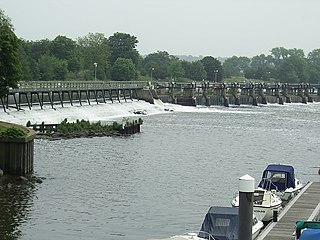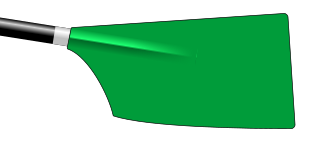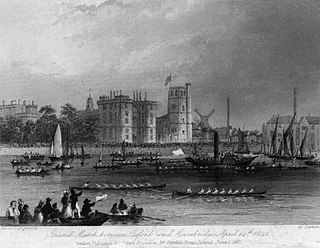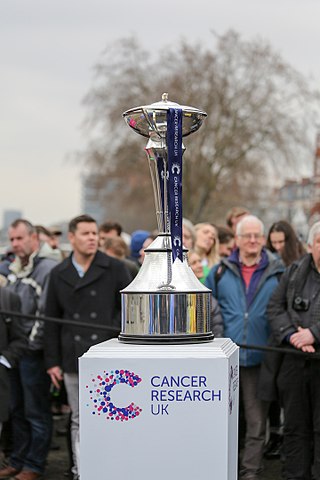
Rowing, sometimes called crew in the United States, is the sport of racing boats using oars. It differs from paddling sports in that rowing oars are attached to the boat using oarlocks, while paddles are not connected to the boat. Rowing is divided into two disciplines: sculling and sweep rowing. In sculling, each rower holds two oars—one in each hand, while in sweep rowing each rower holds one oar with both hands. There are several boat classes in which athletes may compete, ranging from single sculls, occupied by one person, to shells with eight rowers and a coxswain, called eights. There are a wide variety of course types and formats of racing, but most elite and championship level racing is conducted on calm water courses 2 kilometres (1.2 mi) long with several lanes marked using buoys.

Henley Royal Regatta is a rowing event held annually on the River Thames by the town of Henley-on-Thames, England. It was established on 26 March 1839. It differs from the three other regattas rowed over approximately the same course, Henley Women's Regatta, Henley Masters Regatta, and Henley Town and Visitors' Regatta, each of which is an entirely separate event.

The Head of the River Race (HORR) is an against-the-clock ('processional') rowing race held annually on the River Thames in London, England between eights, other such races being the Schools' Head of the River Race, Women's Head of the River Race and Veterans' Head of the River Race. Its competitors are, with a few experienced junior exceptions, seniors of UK or overseas competitors and it runs with the ebb tide down the 4.25 mile (6.8 km) Championship Course from Mortlake to Putney which hosts the Oxford and Cambridge head-to-head races usually between one and two weeks later.

A head race is a time-trial competition in the sport of rowing. Head races are typically held in the fall, winter and spring seasons. These events draw many athletes as well as observers. In this form of racing, rowers race against the clock where the crew or rower completing the course in the shortest time in their age, ability and boat-class category is deemed the winner.

The Devizes to Westminster International Canoe Marathon is a marathon canoe race in England. The race is held every Easter over a course of 125 miles (201 km) from Devizes in Wiltshire to Westminster in central London. It has been run since 1948. Starting at Devizes wharf, the route follows the Kennet and Avon canal for 54 miles to Reading, where it joins the Thames. Another 54 miles later it reaches Teddington Lock, ending 17 miles later at Westminster Bridge.

The Championship Course is a stretch of the River Thames between Mortlake and Putney in London, England. It is a well-established course for rowing races, particularly the Oxford and Cambridge Boat Race. The course is on the tidal reaches of the river often referred to as the Tideway. Due to the iconic shape of the Championship Course, in orthopaedic surgery, an "S" shaped incision along the crease of the elbow is commonly referred to as "a boat-race incision resembling the River Thames from Putney to Mortlake."

Vesta Rowing Club is a rowing club based on the Tideway of the River Thames in Putney, London, England. It was founded in 1870.
In competitive rowing, the following specialized terms are important in the corresponding aspects of the sport:

The Tideway is a part of the River Thames in England which is subject to tides. This stretch of water is downstream from Teddington Lock. The Tideway comprises the upper Thames Estuary including the Pool of London.

Hampton School Boat Club (HSBC) is the rowing club of Hampton School. Each year the club produces 1st VIIIs that compete at Championship level in the United Kingdom. The club hosts two Head race events each year.

Jesus College Boat Club is a rowing club for members of Jesus College, Oxford, one of the constituent colleges of the University of Oxford. The club was formed in 1835, but rowing at the college predates the club's foundation: a boat from the college was involved in the earliest recorded races between college crews at Oxford in 1815, when it competed against Brasenose College. In the early years of rowing at Oxford, Jesus was one of the few colleges that participated in races. Neither the men's nor the women's 1st VIIIs have earned the title of "Head of the River", which is gained by winning Eights Week—the main inter-college rowing competition at Oxford.

Mark Lochrin Edwards is an English traditional boatbuilder based at Richmond Bridge in Richmond, London, England. He has constructed several significant reproductions of vintage boats and built the Royal barge Gloriana, the lead ship in the Thames Diamond Jubilee Pageant in June 2012.
The Thames is one of the main rowing rivers in Europe. Dorney Lake between Slough and Windsor, Berkshire is an international Cup, standard-distance rowing lake besides the Thames, and hosts the three main annual entry regattas for Henley: still named Marlow (International), Wallingford and Metropolitan. Other rowing lakes near the Thames are the Redgrave Pinsent Rowing Lake between Reading and Henley used by the Great Britain squad and Royal Albert Dock near North Woolwich, London.

Gloriana is a British royal barge. She was privately commissioned as a tribute to Queen Elizabeth II for her 2012 Diamond Jubilee, and was the lead vessel in the Thames Diamond Jubilee Pageant.
The 155th Boat Race took place on 29 March 2009. Oxford's crew was the heaviest in the event's history and which featured five Olympic rowers, including silver medallist Colin Smith and bronze medallist George Bridgewater. Cambridge took an early lead, only to be caught and overtaken by Oxford, who won the race by 3+1⁄2 lengths.

The 5th Boat Race took place on the River Thames on 14 April 1841. It was the fourth of the University Boat Races, a side-by-side rowing competition between the University of Oxford and the University of Cambridge, to be contested in London. The race was held between Westminster Bridge and Putney Bridge and was won by Cambridge, whose crew featured two pairs of brothers rowing, who defeated Oxford by a distance of 22 lengths in a time of 32 minutes and 30 seconds. The victory took the overall record in the event to 4–1 in Cambridge's favour.
The 106th The Boat Race took place on 2 April 1960. Held annually, the Boat Race is a side-by-side rowing race between crews from the Universities of Oxford and Cambridge along the River Thames. Oxford went into the race as reigning champions, having won the previous year's race. In a race umpired by former Cambridge rower Kenneth Payne and attended by Princess Margaret, Countess of Snowdon, it was won by Oxford by 1+1⁄4 lengths in a time of 18 minutes 59 seconds, their second consecutive victory, which took the overall record in the event to 58–47 in Cambridge's favour.
The 107th Boat Race took place on 1 April 1961. Held annually, the Boat Race is a side-by-side rowing race between crews from the Universities of Oxford and Cambridge along the River Thames. The race which was delayed, the lead changed hands several times and an Oxford rower slumped and nearly fell out of the boat. It was won by Cambridge by 4+1⁄4 lengths in a time of 19 minutes 22 seconds.

The Boat Race 2018 took place on 24 March 2018. Held annually, The Boat Race is a side-by-side rowing race between crews from the universities of Oxford and Cambridge along a 4.2-mile (6.8 km) tidal stretch of the River Thames in south-west London. For the third time in the history of the event, the men's, women's and both reserves' races were all held on the Tideway on the same day.

















